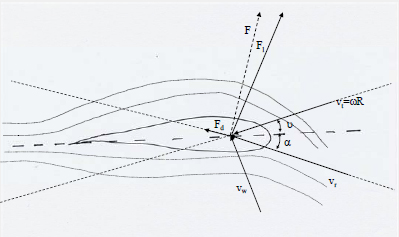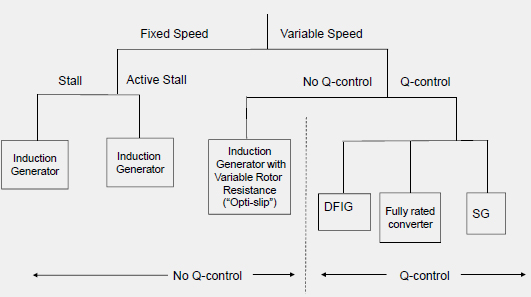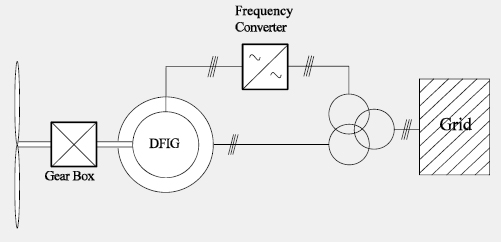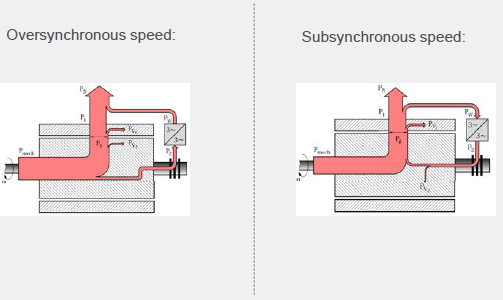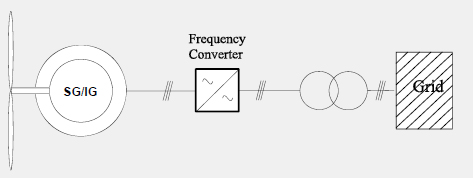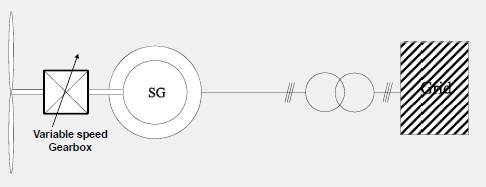Click here to register!
Difference between revisions of "Wind Turbine Technology"
***** (***** | *****) m |
***** (***** | *****) |
||
| Line 1: | Line 1: | ||
| − | {{Revision|(PLEASE HELP TO FILL THIS ARTICLE WITH MORE INFORMATION.).}} | + | |
| + | {{Revision|(PLEASE HELP TO FILL THIS ARTICLE WITH MORE INFORMATION.).}} | ||
<span style="color: rgb(255, 0, 0)"></span> | <span style="color: rgb(255, 0, 0)"></span> | ||
| Line 5: | Line 6: | ||
== Introduction<br/> == | == Introduction<br/> == | ||
| + | <span style="font-size: 0.85em;">A wind turbine is a device that converts kinetic energy from the wind into electrical power</span><ref name="http://en.wikipedia.org/wiki/Wind_turbine">http://en.wikipedia.org/wiki/Wind_turbine</ref>.<span style="font-size: 0.85em;">The role of wind turbines is to extract energy from wind and convert it to electrical energy. This extraction is subjected to certain limitations represented by Betz’s limit which is the maximum energy possible to convert kinetic energy into mechanical energy without any losses<ref name="J. F. Manwell, J. G. McGowan and A. L. Rogers. WIND ENERGY; Theory, Design and Application. United Kingdom : John Wiley & Sons Ltd, 2009">J. F. Manwell, J. G. McGowan and A. L. Rogers. WIND ENERGY; Theory, Design and Application. United Kingdom : John Wiley & Sons Ltd, 2009</ref>.</span> | ||
| + | == Wind Turbine Control Concepts<br/> == | ||
| − | + | An ideal wind turbine has a maximum power coefficient of 16/27.The theoretical limit cannot be exceeded and this caused by the aerodynamic losses due to conversion of angular momentum,tip and drag<ref>DESIGN AND POWER CHARACTERIZATION OF A SMALL WIND TURBINE MODEL IN PARTIAL LOAD REGION by Abdulkarim Abdulrazek</ref>. | |
=== Aerodynamics<br/> === | === Aerodynamics<br/> === | ||
| − | [[File:Wind turbine blade aerodynamics.jpg|frame|center|Aerodynamics of a wind turbine blade]]<ref>Weigel S., Poeller M. (2010) Wind Turbine Generators (WTGs) Physical Principals and Generator Concepts, Presentation prepared by DigSILENT GmbH for the Wind Energy and Development Dialogue 2010, retrieved 27.8.2011 [[http://www.gtz.de/de/dokumente/gtz2010-en-wedd-1-2-WTG-concepts.pdf]]</ref> | + | [[File:Wind turbine blade aerodynamics.jpg|frame|center|180px|Aerodynamics of a wind turbine blade]]<ref>Weigel S., Poeller M. (2010) Wind Turbine Generators (WTGs) Physical Principals and Generator Concepts, Presentation prepared by DigSILENT GmbH for the Wind Energy and Development Dialogue 2010, retrieved 27.8.2011 [[http://www.gtz.de/de/dokumente/gtz2010-en-wedd-1-2-WTG-concepts.pdf]]</ref> |
=== Stall === | === Stall === | ||
| − | [[File:Wind turbine blade aerodynamics - stall control.jpg|frame|center|Wind turbine blade aerodynamics - stall control]]<ref>Weigel S., Poeller M. (2010) Wind Turbine Generators (WTGs) Physical Principals and Generator Concepts, Presentation prepared by DigSILENT GmbH for the Wind Energy and Development Dialogue 2010, retrieved 27.8.2011 [[http://www.gtz.de/de/dokumente/gtz2010-en-wedd-1-2-WTG-concepts.pdf]]</ref> | + | [[File:Wind turbine blade aerodynamics - stall control.jpg|frame|center|180px|Wind turbine blade aerodynamics - stall control]]<ref>Weigel S., Poeller M. (2010) Wind Turbine Generators (WTGs) Physical Principals and Generator Concepts, Presentation prepared by DigSILENT GmbH for the Wind Energy and Development Dialogue 2010, retrieved 27.8.2011 [[http://www.gtz.de/de/dokumente/gtz2010-en-wedd-1-2-WTG-concepts.pdf]]</ref> |
<u>Stall Control</u>: | <u>Stall Control</u>: | ||
| − | |||
* | * | ||
| Line 24: | Line 26: | ||
Power of the wind turbine is limited by the aerodynamic characteristics of the turbine. | Power of the wind turbine is limited by the aerodynamic characteristics of the turbine. | ||
| − | |||
* | * | ||
| Line 31: | Line 32: | ||
Power of the wind turbine is limited additionally by decreasing the pitch angle (increasing the inflow angle ). | Power of the wind turbine is limited additionally by decreasing the pitch angle (increasing the inflow angle ). | ||
| − | + | <br/> | |
=== Pitch<br/> === | === Pitch<br/> === | ||
| − | [[File:Wind turbine blade aerodynamics - pitching.jpg|frame|center|Aerodynamics at a wind turbine blade during control through pitching]]<ref>Weigel S., Poeller M. (2010) Wind Turbine Generators (WTGs) Physical Principals and Generator Concepts, Presentation prepared by DigSILENT GmbH for the Wind Energy and Development Dialogue 2010, retrieved 27.8.2011 [[http://www.gtz.de/de/dokumente/gtz2010-en-wedd-1-2-WTG-concepts.pdf]]</ref> | + | [[File:Wind turbine blade aerodynamics - pitching.jpg|frame|center|180px|Aerodynamics at a wind turbine blade during control through pitching]]<ref>Weigel S., Poeller M. (2010) Wind Turbine Generators (WTGs) Physical Principals and Generator Concepts, Presentation prepared by DigSILENT GmbH for the Wind Energy and Development Dialogue 2010, retrieved 27.8.2011 [[http://www.gtz.de/de/dokumente/gtz2010-en-wedd-1-2-WTG-concepts.pdf]]</ref> |
<u>Pitch Control:</u> | <u>Pitch Control:</u> | ||
| − | |||
*Power of the wind turbine is limited by increasing the pitch angle (decreasing the inflow angle <span class="texhtml">α</span>) | *Power of the wind turbine is limited by increasing the pitch angle (decreasing the inflow angle <span class="texhtml">α</span>) | ||
| − | + | <br/> | |
== Wind Turbine Operation<br/> == | == Wind Turbine Operation<br/> == | ||
| Line 52: | Line 52: | ||
*In case of large wind speeds: Power limited by aerodynamic profile. | *In case of large wind speeds: Power limited by aerodynamic profile. | ||
| − | + | <br/> | |
=== Operation of Variable Speed Wind-Turbines<br/> === | === Operation of Variable Speed Wind-Turbines<br/> === | ||
| − | Start up (with open breaker) if wind speed > cut-in wi[[File:Typical power curves of wind turbines.jpg|frame|right|Typical power curves of wind turbines.jpg]]nd speed<br/>• Close breaker | + | Start up (with open breaker) if wind speed > cut-in wi[[File:Typical power curves of wind turbines.jpg|frame|right|180px|Typical power curves of wind turbines.jpg]]nd speed<br/>• Close breaker |
| − | |||
| − | |||
| + | <br/> | ||
| + | <br/> | ||
• Below rated wind-speed<br/>– Maximum power coefficient (Max. Power Tracking) | • Below rated wind-speed<br/>– Maximum power coefficient (Max. Power Tracking) | ||
| + | <br/> | ||
| − | + | <br/> | |
| − | |||
– Evt: Speed Limitation<br/>• Above rated wind-speed:<br/>– P=Pr<br/>ated (Limited by power electronics converter)<br/>– Pitching | – Evt: Speed Limitation<br/>• Above rated wind-speed:<br/>– P=Pr<br/>ated (Limited by power electronics converter)<br/>– Pitching | ||
| Line 72: | Line 72: | ||
• Advantages of variable speed operation:<br/>– Lower cut-in wind speeds<br/>– Higher efficiency, especially at low wind speeds<br/>– Lower power variations (compared to fixed speed turbines)<br/>• Disadvantage: More expensive! | • Advantages of variable speed operation:<br/>– Lower cut-in wind speeds<br/>– Higher efficiency, especially at low wind speeds<br/>– Lower power variations (compared to fixed speed turbines)<br/>• Disadvantage: More expensive! | ||
| − | + | <br/> | |
<ref>Weigel S., Poeller M. (2010) Wind Turbine Generators (WTGs) Physical Principals and Generator Concepts, Presentation prepared by DigSILENT GmbH for the Wind Energy and Development Dialogue 2010, retrieved 27.8.2011 [[http://www.gtz.de/de/dokumente/gtz2010-en-wedd-1-2-WTG-concepts.pdf]]</ref> | <ref>Weigel S., Poeller M. (2010) Wind Turbine Generators (WTGs) Physical Principals and Generator Concepts, Presentation prepared by DigSILENT GmbH for the Wind Energy and Development Dialogue 2010, retrieved 27.8.2011 [[http://www.gtz.de/de/dokumente/gtz2010-en-wedd-1-2-WTG-concepts.pdf]]</ref> | ||
| Line 78: | Line 78: | ||
== Generator Concepts<br/> == | == Generator Concepts<br/> == | ||
| − | [[File:Overview Wind generator concepts.jpg|frame|center|Overview Wind generator concepts.jpg]]<ref>Weigel S., Poeller M. (2010) Wind Turbine Generators (WTGs) Physical Principals and Generator Concepts, Presentation prepared by DigSILENT GmbH for the Wind Energy and Development Dialogue 2010, retrieved 27.8.2011 [[http://www.gtz.de/de/dokumente/gtz2010-en-wedd-1-2-WTG-concepts.pdf]]</ref> | + | [[File:Overview Wind generator concepts.jpg|frame|center|180px|Overview Wind generator concepts.jpg]]<ref>Weigel S., Poeller M. (2010) Wind Turbine Generators (WTGs) Physical Principals and Generator Concepts, Presentation prepared by DigSILENT GmbH for the Wind Energy and Development Dialogue 2010, retrieved 27.8.2011 [[http://www.gtz.de/de/dokumente/gtz2010-en-wedd-1-2-WTG-concepts.pdf]]</ref> |
=== Fixed Speed Induction Generator<br/> === | === Fixed Speed Induction Generator<br/> === | ||
| − | [[File:Fixed speed induction generator.jpg|frame|center|Fixed speed induction generator.jpg]]<ref>Weigel S., Poeller M. (2010) Wind Turbine Generators (WTGs) Physical Principals and Generator Concepts, Presentation prepared by DigSILENT GmbH for the Wind Energy and Development Dialogue 2010, retrieved 27.8.2011 [[http://www.gtz.de/de/dokumente/gtz2010-en-wedd-1-2-WTG-concepts.pdf]]</ref> | + | [[File:Fixed speed induction generator.jpg|frame|center|180px|Fixed speed induction generator.jpg]]<ref>Weigel S., Poeller M. (2010) Wind Turbine Generators (WTGs) Physical Principals and Generator Concepts, Presentation prepared by DigSILENT GmbH for the Wind Energy and Development Dialogue 2010, retrieved 27.8.2011 [[http://www.gtz.de/de/dokumente/gtz2010-en-wedd-1-2-WTG-concepts.pdf]]</ref> |
Only fix speed operation possible (stall control required)<br/>• Reactive power compensation required<br/>• No reactive power control capability. Additional devices required:<br/>– TSCs (Thyristor switched capacitors)<br/>– STATCOMs<br/>• Risk of dynamic voltage collapse<br/>GTZ Expert Workshop 2010: Grid and System Integration of Wind Energy, 22/23.11.2010, Berlin/Germany<br/>y g p<br/>– > Typically, wind generators based on induction generators are asked to<br/>disconnect in case of voltage dips | Only fix speed operation possible (stall control required)<br/>• Reactive power compensation required<br/>• No reactive power control capability. Additional devices required:<br/>– TSCs (Thyristor switched capacitors)<br/>– STATCOMs<br/>• Risk of dynamic voltage collapse<br/>GTZ Expert Workshop 2010: Grid and System Integration of Wind Energy, 22/23.11.2010, Berlin/Germany<br/>y g p<br/>– > Typically, wind generators based on induction generators are asked to<br/>disconnect in case of voltage dips | ||
| Line 88: | Line 88: | ||
=== Induction Generator with Variable Rotor Resistance<br/> === | === Induction Generator with Variable Rotor Resistance<br/> === | ||
| − | [[File:Induction Generator with Variable Rotor Resistance.jpg|frame|center|Induction Generator with Variable Rotor Resistance.jpg]]<ref>Weigel S., Poeller M. (2010) Wind Turbine Generators (WTGs) Physical Principals and Generator Concepts, Presentation prepared by DigSILENT GmbH for the Wind Energy and Development Dialogue 2010, retrieved 27.8.2011 [[http://www.gtz.de/de/dokumente/gtz2010-en-wedd-1-2-WTG-concepts.pdf]]</ref> | + | [[File:Induction Generator with Variable Rotor Resistance.jpg|frame|center|180px|Induction Generator with Variable Rotor Resistance.jpg]]<ref>Weigel S., Poeller M. (2010) Wind Turbine Generators (WTGs) Physical Principals and Generator Concepts, Presentation prepared by DigSILENT GmbH for the Wind Energy and Development Dialogue 2010, retrieved 27.8.2011 [[http://www.gtz.de/de/dokumente/gtz2010-en-wedd-1-2-WTG-concepts.pdf]]</ref> |
Simple concept for variable speed operation.<br/>• Reactive power compensation required.<br/>• No reactive power control capability. Additional devices required:<br/>– TSCs (Thyristor switched capacitors)<br/>– STATCOMs<br/>• Limited LVRT capability. Dynamic voltage collapse problems have to<br/>GTZ Expert Workshop 2010: Grid and System Integration of Wind Energy, 22/23.11.2010, Berlin/Germany<br/>be mitigated by:<br/>– Fast increase of rotor resistance during faults<br/>– Additional reactive power compensation devices (typically TSCs) | Simple concept for variable speed operation.<br/>• Reactive power compensation required.<br/>• No reactive power control capability. Additional devices required:<br/>– TSCs (Thyristor switched capacitors)<br/>– STATCOMs<br/>• Limited LVRT capability. Dynamic voltage collapse problems have to<br/>GTZ Expert Workshop 2010: Grid and System Integration of Wind Energy, 22/23.11.2010, Berlin/Germany<br/>be mitigated by:<br/>– Fast increase of rotor resistance during faults<br/>– Additional reactive power compensation devices (typically TSCs) | ||
| − | + | <br/> | |
=== Doubly-Fed Induction Generator<br/> === | === Doubly-Fed Induction Generator<br/> === | ||
| − | [[File:Doubly-fed induction generator.jpg|frame|center|Doubly-fed induction generator.jpg]]<ref>Weigel S., Poeller M. (2010) Wind Turbine Generators (WTGs) Physical Principals and Generator Concepts, Presentation prepared by DigSILENT GmbH for the Wind Energy and Development Dialogue 2010, retrieved 27.8.2011 [[http://www.gtz.de/de/dokumente/gtz2010-en-wedd-1-2-WTG-concepts.pdf]]</ref>[[File:Doubly fed induction generatorf Power flow over- and subsyncronous speed.jpg|frame|center|Doubly fed induction generatorf Power flow over- and subsyncronous speed.jpg]]<ref>Weigel S., Poeller M. (2010) Wind Turbine Generators (WTGs) Physical Principals and Generator Concepts, Presentation prepared by DigSILENT GmbH for the Wind Energy and Development Dialogue 2010, retrieved 27.8.2011 [[http://www.gtz.de/de/dokumente/gtz2010-en-wedd-1-2-WTG-concepts.pdf]]</ref> | + | [[File:Doubly-fed induction generator.jpg|frame|center|180px|Doubly-fed induction generator.jpg]]<ref>Weigel S., Poeller M. (2010) Wind Turbine Generators (WTGs) Physical Principals and Generator Concepts, Presentation prepared by DigSILENT GmbH for the Wind Energy and Development Dialogue 2010, retrieved 27.8.2011 [[http://www.gtz.de/de/dokumente/gtz2010-en-wedd-1-2-WTG-concepts.pdf]]</ref>[[File:Doubly fed induction generatorf Power flow over- and subsyncronous speed.jpg|frame|center|180px|Doubly fed induction generatorf Power flow over- and subsyncronous speed.jpg]]<ref>Weigel S., Poeller M. (2010) Wind Turbine Generators (WTGs) Physical Principals and Generator Concepts, Presentation prepared by DigSILENT GmbH for the Wind Energy and Development Dialogue 2010, retrieved 27.8.2011 [[http://www.gtz.de/de/dokumente/gtz2010-en-wedd-1-2-WTG-concepts.pdf]]</ref> |
=== Generator with Fully Rated Converter === | === Generator with Fully Rated Converter === | ||
| − | [[File:Generator with Fully Rated Converter Kopie.jpg|frame|center|Generator with Fully Rated Converter Kopie.jpg]]<ref>Weigel S., Poeller M. (2010) Wind Turbine Generators (WTGs) Physical Principals and Generator Concepts, Presentation prepared by DigSILENT GmbH for the Wind Energy and Development Dialogue 2010, retrieved 27.8.2011 [[http://www.gtz.de/de/dokumente/gtz2010-en-wedd-1-2-WTG-concepts.pdf]]</ref> | + | [[File:Generator with Fully Rated Converter Kopie.jpg|frame|center|180px|Generator with Fully Rated Converter Kopie.jpg]]<ref>Weigel S., Poeller M. (2010) Wind Turbine Generators (WTGs) Physical Principals and Generator Concepts, Presentation prepared by DigSILENT GmbH for the Wind Energy and Development Dialogue 2010, retrieved 27.8.2011 [[http://www.gtz.de/de/dokumente/gtz2010-en-wedd-1-2-WTG-concepts.pdf]]</ref> |
=== Generator with Fully Rated Converter and Direct Drive<br/> === | === Generator with Fully Rated Converter and Direct Drive<br/> === | ||
| − | [[File:Generator with Fully Rated Converter and direct drive.jpg|frame|center|Generator with Fully Rated Converter and direct drive.jpg]]<ref>Weigel S., Poeller M. (2010) Wind Turbine Generators (WTGs) Physical Principals and Generator Concepts, Presentation prepared by DigSILENT GmbH for the Wind Energy and Development Dialogue 2010, retrieved 27.8.2011 [[http://www.gtz.de/de/dokumente/gtz2010-en-wedd-1-2-WTG-concepts.pdf]]</ref> | + | [[File:Generator with Fully Rated Converter and direct drive.jpg|frame|center|180px|Generator with Fully Rated Converter and direct drive.jpg]]<ref>Weigel S., Poeller M. (2010) Wind Turbine Generators (WTGs) Physical Principals and Generator Concepts, Presentation prepared by DigSILENT GmbH for the Wind Energy and Development Dialogue 2010, retrieved 27.8.2011 [[http://www.gtz.de/de/dokumente/gtz2010-en-wedd-1-2-WTG-concepts.pdf]]</ref> |
=== Directly Coupled Synchronous Generator with Variable Gear Box<br/> === | === Directly Coupled Synchronous Generator with Variable Gear Box<br/> === | ||
| − | [[File:Directly Coupled Synchronous Generator with Variable Gear Box.jpg|frame|center|Directly Coupled Synchronous Generator with Variable Gear Box.jpg]]<ref>Weigel S., Poeller M. (2010) Wind Turbine Generators (WTGs) Physical Principals and Generator Concepts, Presentation prepared by DigSILENT GmbH for the Wind Energy and Development Dialogue 2010, retrieved 27.8.2011 [[http://www.gtz.de/de/dokumente/gtz2010-en-wedd-1-2-WTG-concepts.pdf]]</ref> | + | [[File:Directly Coupled Synchronous Generator with Variable Gear Box.jpg|frame|center|180px|Directly Coupled Synchronous Generator with Variable Gear Box.jpg]]<ref>Weigel S., Poeller M. (2010) Wind Turbine Generators (WTGs) Physical Principals and Generator Concepts, Presentation prepared by DigSILENT GmbH for the Wind Energy and Development Dialogue 2010, retrieved 27.8.2011 [[http://www.gtz.de/de/dokumente/gtz2010-en-wedd-1-2-WTG-concepts.pdf]]</ref> |
== References == | == References == | ||
| Line 114: | Line 114: | ||
<references /> | <references /> | ||
| − | [[Portal:Wind]] | + | [[Portal:Wind|Portal:Wind]] |
[[Category:Wind]] | [[Category:Wind]] | ||
Revision as of 14:14, 19 February 2014
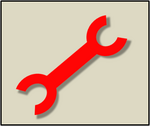 |
This article needs to be revised. Please rewrite the article according to the specifications below. Only remove this maintenance box after a thorough revision of this article. See the discussion page for more details or start a discussion there. In particular the following aspects and passages have been specified to be in need for a revision: |
Introduction
A wind turbine is a device that converts kinetic energy from the wind into electrical power[1].The role of wind turbines is to extract energy from wind and convert it to electrical energy. This extraction is subjected to certain limitations represented by Betz’s limit which is the maximum energy possible to convert kinetic energy into mechanical energy without any losses[2].
Wind Turbine Control Concepts
An ideal wind turbine has a maximum power coefficient of 16/27.The theoretical limit cannot be exceeded and this caused by the aerodynamic losses due to conversion of angular momentum,tip and drag[3].
Aerodynamics
Stall
Stall Control:
Passive Stall
Power of the wind turbine is limited by the aerodynamic characteristics of the turbine.
Active Stall
Power of the wind turbine is limited additionally by decreasing the pitch angle (increasing the inflow angle ).
Pitch
Pitch Control:
- Power of the wind turbine is limited by increasing the pitch angle (decreasing the inflow angle α)
Wind Turbine Operation
Operation of Fix Speed Wind Turbine (Passive Stall)
- Start up (with open breaker) if wind speed > cut-in wind speed
- Close breaker
- Operation at constant blade angle over the whole wind speed range
- In case of large wind speeds: Power limited by aerodynamic profile.
Operation of Variable Speed Wind-Turbines
Start up (with open breaker) if wind speed > cut-in wi
nd speed
• Close breaker
• Below rated wind-speed
– Maximum power coefficient (Max. Power Tracking)
– Evt: Speed Limitation
• Above rated wind-speed:
– P=Pr
ated (Limited by power electronics converter)
– Pitching
• Advantages of variable speed operation:
– Lower cut-in wind speeds
– Higher efficiency, especially at low wind speeds
– Lower power variations (compared to fixed speed turbines)
• Disadvantage: More expensive!
Generator Concepts
Fixed Speed Induction Generator
Only fix speed operation possible (stall control required)
• Reactive power compensation required
• No reactive power control capability. Additional devices required:
– TSCs (Thyristor switched capacitors)
– STATCOMs
• Risk of dynamic voltage collapse
GTZ Expert Workshop 2010: Grid and System Integration of Wind Energy, 22/23.11.2010, Berlin/Germany
y g p
– > Typically, wind generators based on induction generators are asked to
disconnect in case of voltage dips
Induction Generator with Variable Rotor Resistance
Simple concept for variable speed operation.
• Reactive power compensation required.
• No reactive power control capability. Additional devices required:
– TSCs (Thyristor switched capacitors)
– STATCOMs
• Limited LVRT capability. Dynamic voltage collapse problems have to
GTZ Expert Workshop 2010: Grid and System Integration of Wind Energy, 22/23.11.2010, Berlin/Germany
be mitigated by:
– Fast increase of rotor resistance during faults
– Additional reactive power compensation devices (typically TSCs)
Doubly-Fed Induction Generator
Generator with Fully Rated Converter
Generator with Fully Rated Converter and Direct Drive
Directly Coupled Synchronous Generator with Variable Gear Box
References
- ↑ http://en.wikipedia.org/wiki/Wind_turbine
- ↑ J. F. Manwell, J. G. McGowan and A. L. Rogers. WIND ENERGY; Theory, Design and Application. United Kingdom : John Wiley & Sons Ltd, 2009
- ↑ DESIGN AND POWER CHARACTERIZATION OF A SMALL WIND TURBINE MODEL IN PARTIAL LOAD REGION by Abdulkarim Abdulrazek
- ↑ Weigel S., Poeller M. (2010) Wind Turbine Generators (WTGs) Physical Principals and Generator Concepts, Presentation prepared by DigSILENT GmbH for the Wind Energy and Development Dialogue 2010, retrieved 27.8.2011 [[1]]
- ↑ Weigel S., Poeller M. (2010) Wind Turbine Generators (WTGs) Physical Principals and Generator Concepts, Presentation prepared by DigSILENT GmbH for the Wind Energy and Development Dialogue 2010, retrieved 27.8.2011 [[2]]
- ↑ Weigel S., Poeller M. (2010) Wind Turbine Generators (WTGs) Physical Principals and Generator Concepts, Presentation prepared by DigSILENT GmbH for the Wind Energy and Development Dialogue 2010, retrieved 27.8.2011 [[3]]
- ↑ Weigel S., Poeller M. (2010) Wind Turbine Generators (WTGs) Physical Principals and Generator Concepts, Presentation prepared by DigSILENT GmbH for the Wind Energy and Development Dialogue 2010, retrieved 27.8.2011 [[4]]
- ↑ Weigel S., Poeller M. (2010) Wind Turbine Generators (WTGs) Physical Principals and Generator Concepts, Presentation prepared by DigSILENT GmbH for the Wind Energy and Development Dialogue 2010, retrieved 27.8.2011 [[5]]
- ↑ Weigel S., Poeller M. (2010) Wind Turbine Generators (WTGs) Physical Principals and Generator Concepts, Presentation prepared by DigSILENT GmbH for the Wind Energy and Development Dialogue 2010, retrieved 27.8.2011 [[6]]
- ↑ Weigel S., Poeller M. (2010) Wind Turbine Generators (WTGs) Physical Principals and Generator Concepts, Presentation prepared by DigSILENT GmbH for the Wind Energy and Development Dialogue 2010, retrieved 27.8.2011 [[7]]
- ↑ Weigel S., Poeller M. (2010) Wind Turbine Generators (WTGs) Physical Principals and Generator Concepts, Presentation prepared by DigSILENT GmbH for the Wind Energy and Development Dialogue 2010, retrieved 27.8.2011 [[8]]
- ↑ Weigel S., Poeller M. (2010) Wind Turbine Generators (WTGs) Physical Principals and Generator Concepts, Presentation prepared by DigSILENT GmbH for the Wind Energy and Development Dialogue 2010, retrieved 27.8.2011 [[9]]
- ↑ Weigel S., Poeller M. (2010) Wind Turbine Generators (WTGs) Physical Principals and Generator Concepts, Presentation prepared by DigSILENT GmbH for the Wind Energy and Development Dialogue 2010, retrieved 27.8.2011 [[10]]
- ↑ Weigel S., Poeller M. (2010) Wind Turbine Generators (WTGs) Physical Principals and Generator Concepts, Presentation prepared by DigSILENT GmbH for the Wind Energy and Development Dialogue 2010, retrieved 27.8.2011 [[11]]
- ↑ Weigel S., Poeller M. (2010) Wind Turbine Generators (WTGs) Physical Principals and Generator Concepts, Presentation prepared by DigSILENT GmbH for the Wind Energy and Development Dialogue 2010, retrieved 27.8.2011 [[12]]

